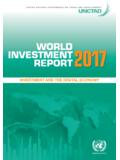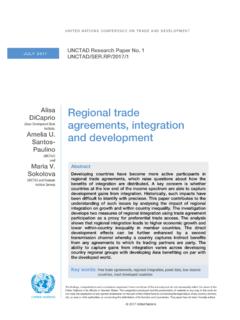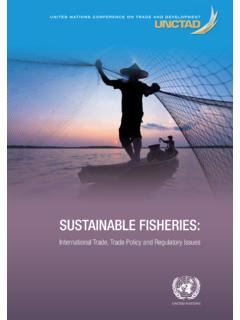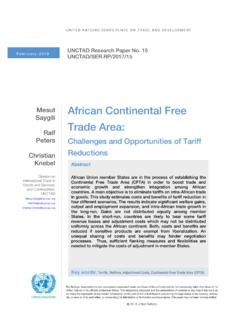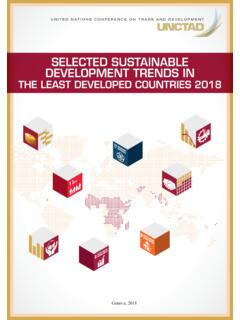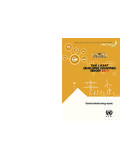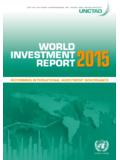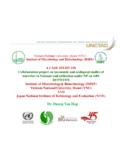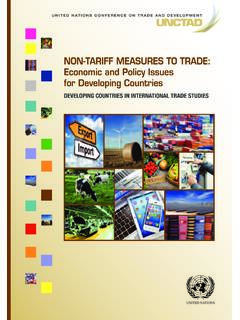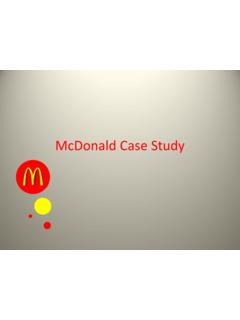Transcription of SAFETY AND QUALITY OF FRESH FRUIT AND VEGETABLES - …
1 SAFETY AND QUALITY OF. FRESH FRUIT AND. VEGETABLES : A TRAINING MANUAL. FOR TRAINERS. UNITED NATIONS. New York and Geneva, 2007. UN CT AD /DI T C / CO M /2 0 0 6 /1 6. ii CONTENTS. Chapter Page v About this Manual .. vi Use of this vii ix xi Important xiii I. INTRODUCTION TO FOOD SAFETY AND QUALITY . 1. Introduction .. 1. MODULE 1: QUALITY Assurance and Food SAFETY .. 2. MODULE 2: QUALITY Attributes, Food Standards, Grading and 6. MODULE 3: Produce Deterioration, Spoilage and Post-harvest Losses .. 10. References .. 14. II. FOOD SAFETY OF FRESH FRUITS AND. VEGETABLES .. 17. Introduction .. 17. MODULE 1: SAFETY Hazards in FRESH Produce: Biological, Chemical and Physical .. 17. MODULE 2: FRESH Produce, Foodborne Diseases and Consumer Health .. 30. References .. 34. III. GOOD AGRICULTURAL PRACTICES .. 37. Introduction .. 37. MODULE 1: Soil and Water .. 38. MODULE 2: Organic and Inorganic 47. MODULE 3: Animal Exclusion and Pest Control.
2 53. MODULE 4: Worker Health and 61. iii Chapter Page MODULE 5: Field and Harvest Sanitation .. 65. References .. 70. IV. GOOD MANUFACTURING PRACTICES .. 71. Introduction .. 71. MODULE 1: Produce Cleaning and Treatment .. 72. MODULE 2: Cooling Procedures .. 75. MODULE 3: Packing, Storage and 78. MODULE 4: Waste Management, Cleaning and Sanitation 84. References .. 92. V. PRINCIPLES AND PRACTICES OF FOOD SAFETY . MANAGEMENT .. 93. Introduction .. 93. MODULE 1: Food SAFETY Management and Existing .. Certification 94. MODULE 2: HACCP 96. MODULE 3: ISO Standards for QUALITY and Food SAFETY Management: ISO 9000 and 22000 .. 100. MODULE 4: Private Industry and Retailer Standards .. 104. References .. 111. VI. FOOD LAWS AND FOOD SAFETY REGULATIONS .. 113. Introduction .. 113. MODULE 1: International Food Laws and 113. MODULE 2: EU Food SAFETY System .. 117. MODULE 3: US Food SAFETY 119. References .. 124. iv BACKGROUND. In recent years, agricultural exports to developed country markets have emerged as a potentially major source of export growth for many developing countries.
3 Exploiting this potential, however, poses many challenges. The capacity of developing country exporters to enter these markets depends critically on their ability to meet stringent food SAFETY standards imposed by developed countries. Not only are these standards stringent, but they are increasingly demanding. They now go well beyond traditional QUALITY standards, as suppliers must pay close attention to the responsible use of agrochemicals, energy, water and waste, as well as social and environmental impact. These standards are significantly higher than those prevailing in developing countries, they are subject to frequent changes and are, ultimately, often difficult and costly to meet. It is anticipated that improving the ability of developing countries to meet food QUALITY and SAFETY standards for horticulture products will facilitate greater international market access, reduce the impact of price competition, stimulate investment and mitigate risk, leading to increased exports.
4 This increase in exports will stimulate commercial production and thus encourage employment creation and increased productivity, benefiting the poor through higher incomes and more jobs. In July 2005, UNCTAD completed the first phase of a Sanitary and Phytosanitary (SPS) project in three selected African LDCs (Guinea, Mozambique and Tanzania). To enhance the gains of this project in the countries selected, the Standards Trade Development Facility (STDF). provided funds to UNCTAD to design a technical assistance follow-up project in Guinea based on the findings of UNCTAD's study on Agrifood SAFETY and SPS Compliance and on recommendations stemming from the national workshop, which took place in July 2005 in Guinea. The overall objective of the project aims to develop a SAFETY control system for horticultural exports ( FRUIT and VEGETABLES ) in Guinea. In particular, the project is intended to (i) improve the capacity of v Guinean producers' associations and export associations to comply with SPS and agri-food SAFETY standards to facilitate exports; (ii) encourage the application of internationally recognized standards by ensuring capacity-building for public and private organizations and; (iii) develop information sharing on standards.
5 The overall strategy used is to work with the horticultural value chain in Guinea (producers, exporters, traders, service providers, public and private technicians, etc.) and to seek EurepGap certification. In the context of the project, UNCTAD initiated plans to develop four national training workshops for Guinean public and private stakeholders on QUALITY assurance and SAFETY of FRESH produce. The participants at these training workshops repeatedly emphasized the critical need for more training opportunities and greater availability of training materials on SAFETY and QUALITY of FRESH fruits and VEGETABLES . ABOUT THIS MANUAL. The objective of this manual is to provide uniform, broad-based scientific and practical information on the safe production, handling, storage and transport of FRESH produce. This manual: (i) Provides a teaching tool to train trainers who will be conducting courses to facilitate the safe production, handling, storage and transport of horticultural exports produced in developing countries exporting to developed country markets and elsewhere.
6 (ii) Serves as a resource for trainers preparing and conducting courses to assist those in the produce industry in identifying and implementing appropriate measures to minimize the risk of microbial contamination while reducing other hazards (chemical and physical) and maintaining market QUALITY . vi The material in this manual is guidance and not regulation and should be applied as appropriate and feasible to individual FRUIT and vegetable operations. USE OF THIS MANUAL. The information presented includes: Principles science-based information regarding elements of produce SAFETY and QUALITY . Topics included are: Introduction to food SAFETY and QUALITY Food SAFETY of FRESH fruits and VEGETABLES Good agricultural practices (GAPs). Good manufacturing practices (GMPs). Principles and practices of food SAFETY management Food laws and food SAFETY regulations Additional Resources include relevant reference documents and web information on issues addressed by this manual.
7 Users of this manual are reminded of the following important considerations in applying its recommendations: (i) The manual focuses on risk reduction, not risk elimination. Current technologies cannot eliminate all potential food SAFETY hazards associated with FRESH produce that will be eaten raw;. (ii) This training manual provides broad, scientifically based principles. Trainers should encourage operators to use the information to help assess microbiological advances that expand understanding of those factors associated with identifying and vii reducing microbial food SAFETY hazards. Awareness of these advances will allow updating of the recommendations and information contained in this manual as appropriate to keep the content current. viii ACKNOWLEDGEMENTS. The Project Manager responsible for the publication of this book was Djidiack Faye, who benefited from substantive input from Ren . Benguerel and Mathias Krebs of Blueyou.
8 Special thanks go to Ms. A k Aka, Expert, who assisted with the book at various stages. This manual could not have been prepared without the SPS project in Guinea financed by the Standards Trade Development Facility (STDF). and, above all, without the tireless effort of the many people involved in its production. We would like to thank all those who very obligingly reviewed the modules of this manual. ix x ACRONYMS. BRC British Retail Consortium CAC Codex Alimentarius Commission CCP Critical Control Point CCvD-HACCP Dutch HACCP Code (Dutch National Board of Experts of HACCP). CIES Global Food Business Forum EFSA European Food SAFETY Authority EU European Union EUREPGAP Euro-Retailer Produce Working Group on Good Agricultural Practices FAO Food and Agriculture Organization of the United Nations FCD F d ration des Enterprises du Commerce et de la Distribution (French retail association). FDA Food and Drug Administration (USA).
9 FMI Food Marketing Institute (American retail association). FSIS United States Food SAFETY and Inspection Service GAP Good Agricultural Practices GATT General Agreement on Tariffs and Trade GFSI Global Food SAFETY Initiative GHP Good Hygiene Practices GMP Good Manufacturing Practices HACCP Hazard Analysis of Critical Control Point HDE Hauptverband des Deutschen Einzelhandels (German retail association). ICM Integrated Crop Management IFS International Food Standard IPM Integrated Pest Management xi IPPC International Plant Protection Convention ISO International Organization for Standardization MAQ Minimum Acceptable QUALITY MRL Maximum Residue Limit OIE Office International des Epizooties (World Organization for Animal Health). QA QUALITY Assurance QMS QUALITY Management System QMS QUALITY Management Systems RASFF Rapid Alert System for Food and Feed (by European Union). SOP Standard Operating Procedures SPS Agreement on Sanitary and Phytosanitary Measures SQF Safe QUALITY Food Standard SQFI Safe QUALITY Food Institute SSOP Standardized Sanitary Operation Procedures TBT Agreement on Technical Barriers to Trade UK United Kingdom UNCTAD United Nations Conference on Trade and Development USA United States of America USDA US Department of Agriculture WHO World Health Organization of the United Nations WTO World Trade Organization of the United Nations xii IMPORTANT DEFINITIONS.
10 The following definitions are applicable to this manual: Accreditation Authoritative process by which a certification body is assessed in its skills and capacities by the accreditation body to carry out certification in compliance with the relevant guidelines Accreditation Authoritative body that evaluates and officially accredits body the certification (and inspection) body Agricultural Water used in the growing environment for agronomic water purposes, including irrigation, transpiration control, frost protection, and as a carrying agent for pesticides and fertilizers Biological Threat posed by living organisms hazard Certificate Written approval for a product or production process showing compliance with underlying standards. Certificates are usually used only in business-to-business relations ( seller and buyer) and not with end consumer (label). Most food SAFETY certification programmes are of this type. Certification Procedure by which a third party gives written assurances that a product or a process is in conformity with a corresponding standard.
